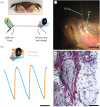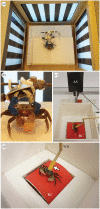Matched function of the neuropil processing optic flow in flies and crabs: the lobula plate mediates optomotor responses in Neohelice granulata
- PMID: 35975436
- PMCID: PMC9382210
- DOI: 10.1098/rspb.2022.0812
Matched function of the neuropil processing optic flow in flies and crabs: the lobula plate mediates optomotor responses in Neohelice granulata
Abstract
When an animal rotates (whether it is an arthropod, a fish, a bird or a human) a drift of the visual panorama occurs over its retina, termed optic flow. The image is stabilized by compensatory behaviours (driven by the movement of the eyes, head or the whole body depending on the animal) collectively termed optomotor responses. The dipteran lobula plate has been consistently linked with optic flow processing and the control of optomotor responses. Crabs have a neuropil similarly located and interconnected in the optic lobes, therefore referred to as a lobula plate too. Here we show that the crabs' lobula plate is required for normal optomotor responses since the response was lost or severely impaired in animals whose lobula plate had been lesioned. The effect was behaviour-specific, since avoidance responses to approaching visual stimuli were not affected. Crabs require simpler optic flow processing than flies (because they move slower and in two-dimensional instead of three-dimensional space), consequently their lobula plates are relatively smaller. Nonetheless, they perform the same essential role in the visual control of behaviour. Our findings add a fundamental piece to the current debate on the evolutionary relationship between the lobula plates of insects and crustaceans.
Keywords: compensatory responses; lobula complex; optic lobes; optokinetic nystagmus.
Conflict of interest statement
We declare we have no competing interests.
Figures





Similar articles
-
A crustacean lobula plate: Morphology, connections, and retinotopic organization.J Comp Neurol. 2018 Jan 1;526(1):109-119. doi: 10.1002/cne.24322. Epub 2017 Sep 18. J Comp Neurol. 2018. PMID: 28884472
-
Neural organization of the third optic neuropil, the lobula, in the highly visual semiterrestrial crab Neohelice granulata.J Comp Neurol. 2022 Jul;530(10):1533-1550. doi: 10.1002/cne.25295. Epub 2022 Jan 25. J Comp Neurol. 2022. PMID: 34985823
-
Binocular Neuronal Processing of Object Motion in an Arthropod.J Neurosci. 2018 Aug 1;38(31):6933-6948. doi: 10.1523/JNEUROSCI.3641-17.2018. Epub 2018 Jul 16. J Neurosci. 2018. PMID: 30012687 Free PMC article.
-
Anatomical organization of retinotopic motion-sensitive pathways in the optic lobes of flies.Microsc Res Tech. 2003 Oct 1;62(2):132-50. doi: 10.1002/jemt.10367. Microsc Res Tech. 2003. PMID: 12966499 Review.
-
Convergent evolution of optic lobe neuropil in Pancrustacea.Arthropod Struct Dev. 2021 Mar;61:101040. doi: 10.1016/j.asd.2021.101040. Epub 2021 Mar 9. Arthropod Struct Dev. 2021. PMID: 33706077 Review.
References
Publication types
MeSH terms
Associated data
LinkOut - more resources
Full Text Sources

